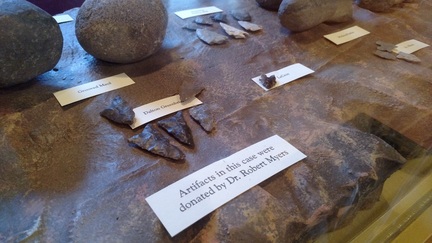The Dr. Robert Myers Collection
About The Collection
Donated in to CAS in 1999, Dr. Myers' collection of Native artifacts was collected in his youth from the Brainerd area of Chattanooga before so much of the area was developed and paved.
The collection is nearly 70 pieces and contains artifacts ranging from arrowheads less than half an inch in length to full sized axe heads. The collection may be viewed daily in the Audubon Acres visitor center. |
In His Words
Growing up in Chattanooga in the 1930’s and 40’s was a neophyte archeologist’s dream. Our house stood on the property which is now occupied by Memorial Hospital in Glenwood. We could walk out our front door and see the remains of the Confederate Army breast works which was defended in the fierce Civil War battle of Missionary Ridge. One could pick up misshapen lead bullets and “Minnie balls” fired during the battle. If one was lucky other souvenirs could be found such as a belt buckle or pieces of equipment. Of added interest were rocks in this same area which contained embedded shell prints and other forms of sea life indicating that they were once on the bottom of the ocean. One’s imagination could run wild!
Of even more interest however were the remnants in the Chattanooga area of prehistoric Indian life. One could walk along the banks of Chickamauga Creek or the banks of the Tennessee River, and other streams and find evidence of ancient villages where the Indians once lived. One of the most prolific areas was the farm land on which Eastgate was later built. Another area was in the region of the current rock quarry in Brainerd.
My father, who was of German farmer decent, loved to walk over farm land. With the owner’s consent, he and I often on Sunday afternoons or holidays would roam the fields along a stream or the river looking for evidence of ancient Indian life. A freshly plowed field was always more productive. We could spot a village or camping spot by the finding of increased amounts of flint chips and other artifacts. We found various sizes and shapes of arrowheads, various tools such as scrapers, knives, and arrowheads. An especially thrilling find would be a game stone and we imagined a group of Indian men playing something like what we call bocce ball in this country.
Eventually I had several boxes full of artifacts which were hard to display so that other people could enjoy them. Audubon Acres seemed the ideal solution to this problem. Not only did it have a talented archeologist available (Dr. Alexander) who could identify, organize and evaluate the collection, but Audubon Acres had a great display area in their museum. The collection was therefore happily given to Audubon Acres to be used as they felt fit.
- Robert W. Myers
Of even more interest however were the remnants in the Chattanooga area of prehistoric Indian life. One could walk along the banks of Chickamauga Creek or the banks of the Tennessee River, and other streams and find evidence of ancient villages where the Indians once lived. One of the most prolific areas was the farm land on which Eastgate was later built. Another area was in the region of the current rock quarry in Brainerd.
My father, who was of German farmer decent, loved to walk over farm land. With the owner’s consent, he and I often on Sunday afternoons or holidays would roam the fields along a stream or the river looking for evidence of ancient Indian life. A freshly plowed field was always more productive. We could spot a village or camping spot by the finding of increased amounts of flint chips and other artifacts. We found various sizes and shapes of arrowheads, various tools such as scrapers, knives, and arrowheads. An especially thrilling find would be a game stone and we imagined a group of Indian men playing something like what we call bocce ball in this country.
Eventually I had several boxes full of artifacts which were hard to display so that other people could enjoy them. Audubon Acres seemed the ideal solution to this problem. Not only did it have a talented archeologist available (Dr. Alexander) who could identify, organize and evaluate the collection, but Audubon Acres had a great display area in their museum. The collection was therefore happily given to Audubon Acres to be used as they felt fit.
- Robert W. Myers

